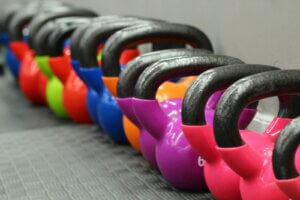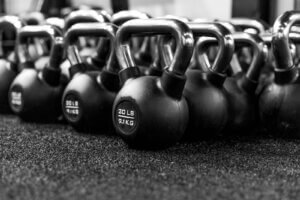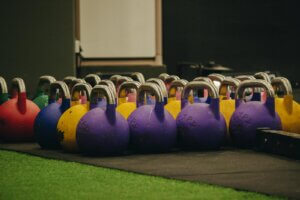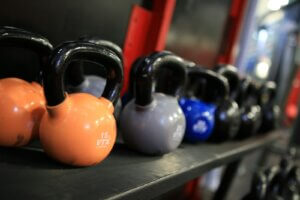How to do Side Plank

Introduction:
The side plank is a fundamental core exercise in CrossFit and general fitness training, renowned for its effectiveness in building strength, stability, and endurance in the core and upper body. This exercise is perfect for those looking to enhance their overall core stability and is particularly beneficial for improving balance and posture. Whether you’re a beginner or an intermediate athlete, mastering the side plank can significantly contribute to your fitness journey. This guide will provide you with an easy-to-follow approach to executing a perfect side plank, including essential equipment, scaling options, common mistakes, and more.
Steps in the Side Plank movement
Starting Position:
- Lie on your side with your legs extended and stacked one on top of the other.
- Place your elbow directly under your shoulder, forming a 90-degree angle with your arm.
- Ensure your head, neck, and spine are aligned.
Lifting Your Body:
- Engage your core muscles and lift your hips off the ground, forming a straight line from your head to your feet.
- Your supporting arm should remain perpendicular to the floor, and your top arm can rest on your side or extend upwards for balance.
Hold the Position:
- Maintain a tight core, ensuring your hips don’t drop or sag.
- Hold the position for the desired amount of time, focusing on controlled breathing.
Lowering Down:
- After holding the plank for your target duration, slowly lower your hips back to the starting position.
- Switch sides and repeat the exercise on the opposite side to ensure balanced muscle development.
What Equipment is needed
- Yoga Mat: Provides cushioning and grip, making it more comfortable to perform the side plank on hard surfaces.
- Timer or Stopwatch: Useful for keeping track of your hold duration.
- Resistance Bands (Optional): Can be used to add resistance and increase the challenge.
While the side plank is primarily a bodyweight exercise requiring minimal equipment, certain tools can enhance comfort, support, and progression. A high-quality yoga mat provides a cushioned surface, reducing pressure on the forearm and ensuring a non-slip foundation during the hold. For individuals seeking to intensify the exercise, incorporating resistance bands can add a layer of difficulty. Looping a resistance band around your thighs or ankles during the side plank challenges the hip abductors and adds resistance to leg movements. Additionally, stability balls or BOSU balls can be utilized to create an unstable surface, further engaging the core muscles and improving balance. Wrist or ankle weights are also effective for increasing the load and promoting muscle endurance. Investing in these accessories can provide variety and progression in your side plank practice, catering to both comfort and challenge as you advance.
Check out the Equipment subsite for more tools, tips, and inspiration.

Shop Fitness gear now on Amazon
See Amazons extensive range of workout gear here. (Affiliate Link)
Scaling Options:
To gradually build strength and proficiency, consider the following scaling options:
Beginner:
- Perform the side plank with your knees bent and on the ground instead of your feet.
- Reduce the hold time to 10-15 seconds and gradually increase as you build strength.
Intermediate:
- Elevate your top leg while holding the plank to increase difficulty.
- Use a resistance band around your thighs to add resistance.
Progressions and Variations of the Side Plank
To keep your workouts engaging and to continue challenging your muscles, it’s beneficial to explore various progressions and modifications of the side plank. Starting with the basic side plank, you can gradually increase the difficulty as your strength and stability improve. For beginners, performing the side plank with bent knees reduces the load and helps in mastering the correct form. As you advance, extending the duration of the hold or incorporating movements like hip dips can intensify the exercise. Elevating your feet on a stable surface or performing the side plank with your forearm on an unstable surface, such as a BOSU ball, can further challenge your balance and core engagement. Additionally, integrating leg lifts or threading the needle (rotating your torso and bringing your top arm under your body) can add dynamic elements to the static hold, promoting greater muscle activation and functional strength. By progressively adjusting the side plank to match your fitness level, you ensure continuous improvement and prevent workout monotony.
Common Mistakes to Avoid:
- Dropping Hips: Ensure your hips remain in line with your body. Engage your core and glutes to maintain proper alignment.
- Rotating Shoulders: Keep your shoulders stacked and avoid rotating your torso. Focus on maintaining a straight line from head to feet.
- Neck Position: Avoid straining your neck by keeping it in line with your spine. Look straight ahead or down to maintain alignment.
Benefits of the Movement:
- Core Strength: Targets the obliques, transversus abdominis, and other core muscles, improving overall core strength and stability.
- Improved Balance: Enhances balance and coordination, beneficial for various athletic activities and everyday movements.
- Spinal Support: Strengthens muscles that support the spine, promoting better posture and reducing the risk of back injuries.
- Functional Fitness: Mimics real-life movements, making it a practical addition to your workout routine.

Which Muscles Are Worked:
During this exercise, the following muscle groups are engaged:
Primary Muscles:
- Obliques
- Transversus Abdominis
Secondary Muscles:
- Glutes
- Shoulders (Deltoids)
- Lower Back (Erector Spinae)
Alternative Similar Movements:
If you’re seeking variation or targeting specific muscle groups, consider incorporating these alternative exercises:
- Plank: A classic core exercise that targets similar muscle groups but from a different angle.
- Side-Lying Leg Lifts: Focuses on the obliques and hip abductors, providing a similar stabilization challenge.
- Russian Twists: Engages the obliques and improves rotational strength.
- Bird Dog: A great alternative that targets core stability and balance, involving both the upper and lower body.

Shop Fitness gear now on Amazon
See Amazons extensive range of workout gear here. (Affiliate Link)
Incorporating Side Planks into Your Fitness Routine
Integrating side planks into your regular fitness regimen can significantly enhance core strength and overall stability. Given their focus on the obliques and deep abdominal muscles, side planks are an excellent addition to routines aimed at improving functional fitness. They can be seamlessly included in both strength training and cardiovascular workouts. For instance, adding side planks between sets of upper or lower body exercises can maintain an elevated heart rate while providing core conditioning. Alternatively, incorporating them into a circuit training session can offer a balanced approach to muscle engagement and endurance. It’s advisable to perform side planks after a thorough warm-up and before high-intensity activities to prime the core muscles for stabilization tasks. Aim to hold each side plank for 20-60 seconds, depending on your fitness level, and repeat for 2-3 sets. Regularly practicing side planks, at least 2-3 times per week, can lead to noticeable improvements in posture, balance, and core strength, contributing to enhanced performance in various physical activities.
Safety Precautions and Contraindications
While the side plank is generally safe for most individuals, it’s essential to observe certain precautions to prevent injury. Maintaining proper form is crucial; ensure that your body forms a straight line from head to feet, avoiding sagging or lifting of the hips. Engage your core muscles throughout the hold to support spinal alignment. Individuals with shoulder, elbow, or wrist injuries should approach the side plank with caution, as these joints bear significant weight during the exercise. Modifications, such as performing the plank on the forearm or with knees bent, can reduce strain. It’s advisable to consult with a healthcare provider or fitness professional before incorporating side planks into your routine, especially if you have pre-existing conditions. Listening to your body and progressing gradually are key to safely benefiting from this exercise.
Real-Life Applications and Benefits of Side Plank Strength
The strength and stability gained from regularly performing side planks extend beyond the gym, enhancing daily functional movements. A strong core supports better posture, reducing the risk of back pain and improving balance during activities such as walking, running, or carrying heavy objects. Athletes may notice improved performance in sports that require lateral movements, such as tennis or basketball, due to increased oblique strength and trunk stability. Furthermore, a robust core contributes to overall body mechanics, making everyday tasks more efficient and reducing the likelihood of injuries. By incorporating side planks into your fitness routine, you’re investing in a foundation that supports a wide range of physical activities and promotes long-term health.

Shop Fitness gear now on Amazon
See Amazons extensive range of workout gear here. (Affiliate Link)
Q&A on Side Planks
How to do a proper side plank?
Follow the steps outlined in the “Steps in the Side Plank Movement” section, ensuring your body forms a straight line from head to feet, and engage your core to maintain stability.
What is a side plank good for?
A side plank is excellent for strengthening the obliques, enhancing core stability, and improving balance and coordination.
Why can’t I do a side plank?
Difficulty with side planks often stems from insufficient core strength or improper form. Start with the beginner scaling options to build strength gradually.
How long should a beginner hold a side plank?
A beginner should aim to hold a side plank for 10-15 seconds, gradually increasing the duration as strength improves.
Do side planks give you abs?
Yes, side planks target the obliques and core muscles, contributing to the development of abdominal muscles.
Is side plank easier than plank?
For many, side planks can be more challenging due to the added balance and stability required.
Why are side planks so much harder?
Side planks demand more from your obliques and stabilizing muscles, making them more challenging than standard planks.
Do side planks slim your waist?
Side planks can help tone and strengthen the muscles around your waist, contributing to a slimmer appearance.
Is a 30 second plank bad?
No, a 30-second plank is a good starting point and can be improved upon with consistent practice.
What happens if I do side planks everyday?
Doing side planks daily can significantly improve core strength, stability, and balance, but ensure you allow for rest and recovery as needed.
Are side planks safe?
Yes, side planks are generally safe if performed with proper form and alignment. Avoid them if you have shoulder or wrist issues without consulting a professional.
Will I get abs if I do planks everyday?
Daily planking can help develop your core muscles, but a balanced diet and overall fitness routine are also essential for visible abs.
What is the hardest plank?
The hardest plank variations typically include the one-arm plank and the one-leg plank due to the increased balance and strength required.
Does side plank reduce belly fat?
Side planks can help strengthen and tone the core muscles, but reducing belly fat requires a combination of cardiovascular exercise and a healthy diet.
Are side planks better on hands or elbows?
Both versions are effective, but side planks on the elbows reduce strain on the wrists and may be more comfortable for some people.
Are side planks bad for back?
Side planks can actually improve back health by strengthening the muscles that support the spine. However, improper form can lead to strain, so perform them correctly.
How to get a flat stomach?
Achieving a flat stomach involves a combination of regular exercise, including core workouts, cardiovascular training, and a healthy, balanced diet.
How many side planks should I do a day?
Start with 2-3 sets of side planks per side, holding each plank for 20-30 seconds, and gradually increase as you build strength.
Why don’t I feel my abs during plank?
If you don’t feel your abs during a plank, you may need to engage your core more actively and ensure proper form, with hips and spine aligned.
Is planking for 5 minutes good?
Holding a plank for 5 minutes is an impressive feat and indicates strong core endurance, but shorter, more frequent planks can also be highly effective.
How many planks a day?
Incorporate 3-5 sets of planks into your daily routine, varying the duration and type to keep challenging your core muscles.
Is a 1 minute plank good?
Yes, a 1-minute plank is a solid goal that indicates good core strength and stability.
Is there a wrong way to do a plank?
Yes, common mistakes include sagging hips, arching the back, and looking up or down excessively. Maintain a straight line from head to feet and engage your core.
Should I hold my stomach in while planking?
Yes, engage your core by pulling your belly button towards your spine to activate the abdominal muscles and maintain proper form.
Conclusion:
Incorporating side planks into your workout routine can significantly enhance your core strength and stability. With dedication and consistent practice, you’ll be able to master this exercise, reaping the benefits of a stronger, more balanced body. So, roll out your yoga mat, set your timer, and get ready to hold that plank!

Shop Fitness gear now on Amazon
See Amazons extensive range of workout gear here. (Affiliate Link)

🏋️ Written by: Mike Kerr
Mike is the founder of Strengthguides.com and a certified CrossFit Level 1 Trainer (CF-L1) and certified Kettlebell Instructor with over 10 years of experience in functional fitness. He specializes in developing programs that maximize performance without sacrificing mobility. Mike Kerr is passionate about making complex training methodologies comprehensible and safe for everyone.





